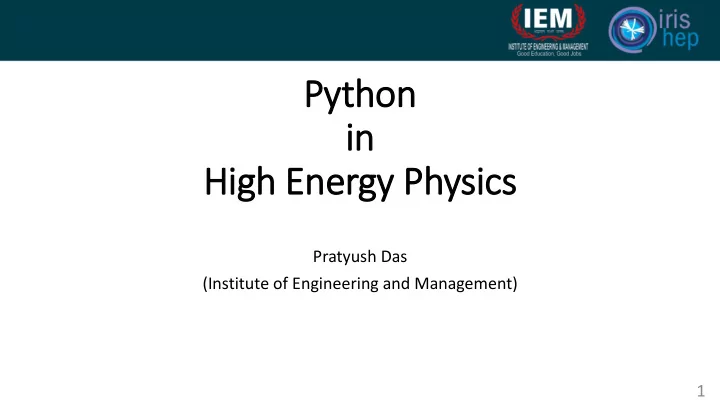

Pyt ython in in Hig igh Energy Physics Pratyush Das (Institute of Engineering and Management) 1
What is is Hig igh En Energy Physic ics? ● Branch of physics that studies the nature of particles that constitute matter and radiation. ● Also known as Particle Physics. ● Asks the big questions - What is our Universe made of? What forces govern it? ● Has the largest scientific collaborations - CMS, ATLAS, etc.. 2
Th The fir first computers were buil ilt for or Physics (excluding secret code breaking computers) 1944: John Mauchly (physicist) and J. Presper Eckert (electrical engineer) designed ENIAC to replace mechanical computers for ballistics. ENIAC was one of the first computers driven by machine code instructions, stored as a program in memory. Los Alamos group led by Nicholas Metropolis, developed Monte Carlo techniques for physics problems. 3
Vis isible le in influence of f Physics 1945: John von Neumann learned of the work on ENIAC and suggested using it for nuclear simulations (H-bomb). His internal memo was leaked; now known as “Von Neumann architecture.” 1952 – 1959: At Remington Rand, Grace Hopper developed a series of compiled languages, ultimately COBOL. 1991: Tim Berners-Lee invents the World Wide Web at CERN. 4
Computing proble lems in in HEP EP - Jim Pivarski, Strange Loop 2017 5
Computing proble lems in in HEP EP - Jim Pivarski, Strange Loop 2017 6
Computing proble lems in in HEP EP - Jim Pivarski, Strange Loop 2017 7
Programming Two programming languages have dominated in the field of High Energy Physics. Languages in High Energy • Upto early 1990s - Fortran PAW, HBOOK, ZEBRA • Physics • Early 1990s to Present Day - C++ ROOT • • Future - Python? Physicists drove programming language development in the 1940’s and 1950’s but stuck with FORTRAN until the 21st century. 8
Requirements of f a la language to be used in in HE HEP Easy Fast Mainstream 9
How do o HEP physicists work wit ith data? Every HEP physicist uses ROOT. It really provides all the functionalities - From plotting graphs to machine learning libraries, all in one monolithic package. Primary reason for dominance of C++ in High Energy Physics. 10
What is is ROOT? • What is all this petabytes of data? – ROOT Files. • It is a file format used for storing physics data – one of the largest open source file formats. • Computing in HEP is ROOT. • The whole HEP ecosystem from detector collision to analysis is in ROOT. Discovery of Higgs Boson 11
ROOT and Pyth ython • ROOT has Python wrappers around its C++ code - PyROOT. • But ROOT has a huge codebase with rapid development - Tedious to add python bindings. • Dynamic Python bindings - cppyy 12
cp cppyy • ROOT doesn’t have separate files for each C++ class to link it to Python . • PyROOT comprises of just 3 main files for generating python bindings from C++ - • ROOT.py • Cppyy.py • _pythonization.py • Initially developed deeply integrated with ROOT. Being re-written by the author(Wim Lavrijsen) as a stand-alone library. 13
Alt Alternate im implementation of of ROOT in in Pyth thon Although PyROOT is improving with cppyy support, it still lacks in some things - 1. Object ownership issues between C++ and Python 2. Not completely Pythonic 3. Slow to deal with certain types of data - jagged arrays There exists an implementation of ROOT I/O in purely Python and Numpy - uproot . Since it is written in python, it implicitly solves the first two issues. 14
uproot – Harbinger of of Python in in HEP? • Really just Python. • Very popular for a new package in HEP. (I am one of the 2 core developers) 15
Pyt ython is is not so so slo slow - Christopher Tunnel, PyHEP 2018 16
Sci cikit-HEP 17
Mach chin ine Le Learning The recent surge in development of machine learning algorithms, particularly deep learning has played a major role in the shift from ROOT and C++ to Python in the form of PyROOT and uproot. ROOT’s machine Learning library TMVA cannot keep up with industry standard libraries such as PyTorch and Tensorflow. Industry leaders in Machine Learning are invited to give talks at HEP conferences. 18
Hear fr from a Physicist - Chris Burr, PyHEP 2018 19
Two ways to approach adoption Python bindings for existing Rewriting projects in Python using projects using cppyy. the existing python ecosystem. • It will be a few years till cppyy • Uproot has proved that it is is mature enough to be used possible to rewrite integral widely outside of ROOT. parts of HEP software in Python. • Once it is generalized, will be • Impossible to rewrite revolutionary. everything in Python. 20
Concludin ing Remarks ● Python is a popular language, even in sciences where performance is critical. ● It has good features for readability and is easy to learn, especially by scientists whose primary interest is not programming. ● Python is the most natural bridge to machine learning and other statistical software written outside of HEP. ● Newcomers are familiar with Python libraries like Pandas and Tensorflow as compared to their HEP alternatives like TMVA. ● Growth of the python ecosphere outperforms growth of C++ ecosphere. ● Python is here to stay! 21
THANK YOU 22
Recommend
More recommend